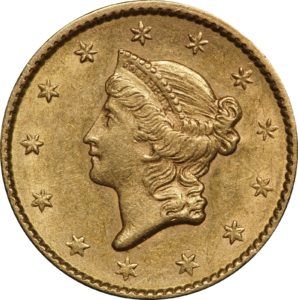Gold Dollars (1849-1889)
Gold Dollars (1849-1854) Type 1
Gold Dollars – The gold dollar, historically known as been the smallest coin in the U.S., may be tiny in size, but it’s certainly made a significant stamp on collectors for its worth and rarity.
Produced in Georgia and the Carolinas, the gold dollar was the result of two huge gold rushes, the first one taking place in the 1800’s. Impacting positively from the gold rush, two branch Mints were established in North Carolina, Dahlonega, and Georgia. This led to a distinctive increase in the  Government producing gold coins.
Government producing gold coins.
Alt Christoph Bechtler, a German immigrant, had privately minted gold dollars produced in the United States. These were the first gold dollars to be made in the U.S. He took advantage of the availability of nuggets and gold dust within the area and offered to refine raw gold into coins at a cost. After turning out over $2.2 million worth of gold coinage by 1840, the Government started issuing their own gold dollar coins; However, Robert M. Patterson (the Mint director) wasn’t in agreement with the decision and was reluctant to strike them, consequently only striking a small number.
When the next gold rush hit the U.S. in 1849, the gold dollar took its rightful place in the coinage line-up. Although still resisting, Patterson saw Congress pass the legislation to authorize gold dollars and double eagles ($20 gold pieces,) in March 1849.
The Mint chief engraver, James Barton Longacre, was tasked with designing both coins, choosing a similar design for them both. He chose to design a portrait of Miss Liberty, left-facing, wearing a crown. Thirteen stars surround her on the dollar, and due to the small coins surface, the back was simple.
The design didn’t change until 1854 when the “Indian Head” portrait replaced Miss Liberty. Two years later, the “Indian head” was enlarged again, leaving three variations of the gold dollar.
Miss Liberty came to be known as “Type 1 gold dollar,” now scarce but available. Collectors usually see their set limited to one example for their type sets, due to the rarity of high-quality pieces available. Although they are small compared to other dollars, their value and uniqueness cannot be ignored, leaving them in high demand with collectors.
Gold Dollars (1854- 1856) Type 2
As California’s population grew from a tiny 25,000 to more than half a million, around $600 million in Gold was discovered. Californians were busy finding their fortune and claiming it while the rest of America was on the edge of a Civil War.
Objections to the gold dollar’s minuscule size were starting toarise, leaving people saying the gold was too easy to misplace. So started the test for a larger coin with center holes. When James Snowden took over as director of the Mint, he indeed agreed on the need for a larger coin but replaced the hole by making a thinner coin, to keep the weight the same. Chief Engraver Longacre was tasked with making the modification and re-designing.
Now the type 2 gold dollar was 15% larger than the original; it was easier to handle and less likely to go missing. However, Branch-mint issues were weak due to the obverse relief been too high, leaving a vast amount struck un-finished as a result. Longacre was sent to the drawing board once more, and the Type 2 dollar made its way out in 1856. Only 1.6 million type 2 dollars were produced.
Given the low amount produced, and the problems arising from production, type 2 is exceptionally rare in mint condition.
Gold Dollars (1856-1889) Type 3
On a mission for the perfect gold dollar, the United States Mint tried again for a success in this coin. The Mint had already started to solve the size problem in 1854 but found another deficiency within the design.
In 1856, Longacre tried again, making the portrait larger, but flatter as well. The design of type 2 and type 3 are essentially the same; it’s pretty much the size and depth of the portrait that is different.
Following the Civil War, the coins were struck in Philadelphia, taking over from Dahlonega and Charlotte after their closures in 1861. There was, however, a San Francisco issue in 1870.
It is easier to find a mint-condition type 3 gold dollar than its earlier editions, due to the amount that was made. Many collectors have wonderful sets consisting of the low mintage coins, made from 1879-1889.
It may have taken three attempts, but they got there in the end. Finally, people were satisfied with not only the size of the dollar but also; its durability. An impressive three decades of production followed uninterrupted until the gold dollar was discontinued in 1889.
